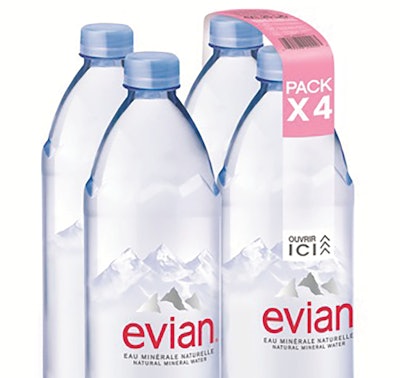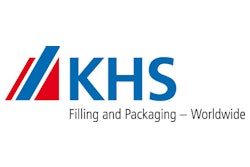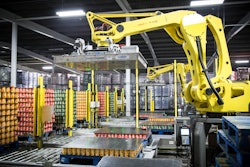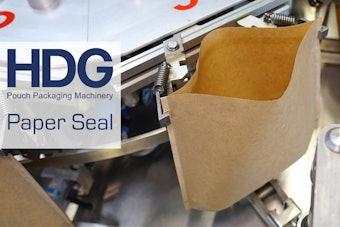
Evian, the part of France’s Danone Group that is based in the French town of Evian-Les-Bains, is introducing a whole new way of multipacking PET bottles. Joining Evian in this development, which goes back to drinktec 2013, is KHS, the German packaging machinery builder that came up with the Nature MultiPack™ technology in the first place. It’s unlikely that either Evian or KHS ever imagined what a challenge they were signing up for when they held their first conversations three years ago at the Munich show. But persistence has paid off, and now Nature MultiPack for 1.25-L “prestige” PET bottles of Evian natural spring water is being launched in select stores across France.
A method of multipacking PET bottles by means of nothing more than a few small dots of specially developed adhesive and a standard tape handle to carry the pack, Nature MultiPack is designed to withstand transportation and merchandising logistics yet allow consumers to easily separate bottles from the multipack. Compared with paperboard, shrink film, and plastic ring carriers, it uses dramatically less packaging material and delivers a premium look and feel. Developed by KHS, it’s being brought to market by NMP Systems, a KHS subsidiary.
Evian is the first to commercialize the innovative Nature MultiPack technology. According to Frederic Maetz, Global Engineering Vice President at Danone Waters and a direct participant in the three-year Evian/KHS collaboration, securing a first-to-market advantage was considered essential by Danone leadership. He also emphasizes how important it was to form a close partnership with KHS-NMP and to involve multiple disciplines within Danone. He sums it up this way: “Danone Waters R&D, engineering, industrialization, quality, and marketing people enjoy working closely together with the dedicated people from KHS and NMP Systems.”
This mutually beneficial relationship between Danone Waters and KHS is one that had to be rebuilt pretty much from scratch. Such a relationship had existed some years back, notes Maetz, because the installed base of KHS equipment in plants operated by Danone Waters was once significant. But by 2013 that base had eroded to the point where KHS didn’t even invite Maetz and his colleagues to see the new multipacking technology when it debuted at drinktec.
“We decided we would have to invite ourselves to the KHS stand,” says Maetz. “It’s a little unusual I suppose for the customer to harass the supplier that way in an effort to buy the supplier’s equipment, but the fact is we really had to figure out who the right contacts were, since this kind of information had been lost over the years.”
The partnership’s progress
The two firms have come a long way since then, says Maetz. “The fact is, this innovation we are now bringing to the marketplace has been the catalyst for a whole new way of doing business together. The emphasis is on innovation. A lot of companies talk about how innovation is part of their DNA, but in our case if you look at the history we have a proven record of innovation in a business that, to be honest, tends to be rather boring. Look around the supermarket and you won’t see a lot of innovation when it comes to water. It’s viewed as nothing more than a commodity. We don’t take that view. We want to add value to the customer experience because we have a premium water. We want to target the higher end of the market and not compete with the commodities that focus on putting water in cheap plastic bottles sold in huge volumes. Our goal is to make this very traditional segment of the supermarket innovative. There are not so many opportunities to do that when the product itself by its very essence must be left alone. Our job is to protect what nature gives us from the source to the bottle. No filtering, no thermal treatment, no chemicals. Just let nature do its work for 15 years and then bring that water into the bottle. Where do you innovate in such an environment? That’s where packaging comes in.”
Maetz explains that every bottle of Evian natural spring water that goes to the marketplace is the same water under the same brand. But the marketplace is viewed as one shaped by two kinds of consumer needs. For daily consumption, especially in European countries, a standard PET bottle works quite nicely. For exceptional occasions and/or premium locales, a prestige bottle is called for, and Evian came out with one in 2013. It incorporates a molded-in decorative element at the shoulder that represents the French Alps.
It’s only this prestige bottle in a 1.25-L format that, for now at least, gets the Nature MultiPack treatment. Could that change in the future? Maetz says it’s certainly being considered. But in view of the breakthrough nature of the technology and the number of technical issues still being worked out, the prestige bottle was the perfect candidate for Nature MultiPack for at least a couple of reasons. First, this new way of multipacking says “premium,” so it’s a good fit for the prestige bottle. Second, the prestige bottle is produced in much lower numbers, which made it attractive from the perspective of scale and scope.
Messaging considerations
Also motivating Evian to keep the roll-out limited at the outset is that a number of questions remain where on-shelf messaging is concerned. “Research shows that the amount of time you have to catch the consumer’s eye in the supermarket aisle is mere seconds if not fractions of seconds,” says Berengere Dupui, Evian Global Innovation Manager at Danone Waters. “When your bottles are ‘naked,’ so to speak, compared to the shrink-wrapped competition, you have to think carefully and strategically about what that means. There’s a consumer education issue to think about, too, because of how radically different this multipack format is compared to what consumers are used to. For example, after early consumer tests with carrying handles that were blank, we now clearly state on the handle that this is indeed a four-pack. As we worked our way through such learnings, it made sense not to launch in a big-volume way at first.”
“Disruptive innovation like this can be very tricky,” adds Didier Joannes, Director of Packaging Engineering at Danone Waters. “You have to dare and take risks, and you need volume to fine-tune your technology. But you have to minimize your risk by limiting the geography of shipping and the volume of production, because you are still learning while doing. It’s a delicate balancing act.”
So far Evian has also been quite selective about which retailer gets the prestige PET bottles in the Nature MultiPack format. All that have gone out so far have gone to the Monoprix chain of high-end stores, where relatively “prestige” consumers are a good fit for a prestige bottle. This month Delhaize, a high-end retailer based in Brussells, Belgium, will be added.
Another interesting aspect of Nature MultiPack revolves around sustainability. This new approach to unitizing individual bottles eliminates significant amounts of shrink film—up to 15 g of printed film is replaced by less than 1g of adhesive. Also, completely eliminated is the consumption of energy required by the heat tunnels that shrink that film tightly around a multipack. So the technology scores some pretty impressive sustainability points. That’s why the word “nature” is part of its moniker.
“There are, to be sure, a number of environmental benefits to be gained from this approach,” says Maetz. “But for now the things we are emphasizing are differentiation, innovation, and a new experience for the consumer.”
‘Learning while doing’
Perhaps the most intriguing part of Evian’s Nature MultiPack journey is the way the technology has had to be tweaked along the way as conditions warranted. This is what Joannes refers to when he speaks of “learning while doing” and “fine-tuning the technology.” The application of adhesive dots is one example. At the outset, so much emphasis was placed on making sure the four bottles would not separate during shipping and distribution that consumers who were tested struggled to get the bottles apart. By eliminating two of these adhesive dots near the bottle shoulder, the multipack became much more user friendly yet performance in shipping and distribution was not affected at all.
Also challenging was the issue of bottle freshness. Early on in the development process the Nature MultiPack machinery was operating at the KHS-NMP lab in Kleve, Germany. Evian would blow bottles, store them for a period of time, and ship them to Kleve whenever KHS-NMP needed them. But when the machinery was moved to the Evian plant and freshly blown bottles had to be handled, the sidewall surface tension was simply not the same as it was on bottles that had had time to cure and be conditioned for a period of time. “It was never a matter of just putting glue on bottles and shipping them out the door,” says Maetz. “We had to make adjustments as we went from testing in Kleve to industrial production here at Evian.”
While on the topic of the adhesive, it’s worth noting that three core development partners, whom KHS can’t name due to contractual reasons, have been involved in developing the adhesive since 2011. Migration tests of glue (food grade) have been carried out from the very beginning, and results are compliant with Danone specifications for Natural Mineral Water. Compatibility with the existing PET bottle recycling stream was also carefully considered, as Danone and KHS worked together on the European PET Bottle Platform (EPBP) dossier. As for the adhesive hot-melt application systems, they were developed internally by KHS specifically to meet the accuracy requirement of the NMP application and are not available in the open market.
The carrying handle has also gone through a number of iterations, though essentially it is a tape handle similar to many out in the marketplace already. A foam component provides some element of cushioning to the consumer’s hand.
And then there’s the issue of bottle orientation so that all four labels face outward once the multipack has been created. This is not something that needs to be addressed when shrink film is the method of multipacking. At Evian, a machine vision system is used, but again, KHS chooses not to identify the supplier.
How it works
As for the sequence of operations, bottles enter the KHS/NMP system in two parallel lanes. On each lane, two starwheels meter the incoming bottles so that they have the desired spacing and speed. Special engineering ensures that the bottles are not damaged during the infeed process.
On each lane there are two turrets and a transfer starwheel in the center. Turret #1 is responsible for bottle orientation, while Turret #2 handles adhesive application. Just before a bottle reaches Turret #1, a vision system captures the position of each label and sends that information into the controller. As the bottle is indexed onto one of the platforms that make up Turret #1, it’s firmly gripped from above and then rotated based on information the vision system sent to the controller. Next a transfer starwheel guides bottles into Turret #2.
Proprietary adhesive guns apply just the right amount of adhesive in two spots on the bottle sidewall. Then the two lanes of bottles are brought together into “compression cars,” four bottles per car, in which they travel a short distance so the adhesive has time to set up and solidify, a process that takes about four seconds. The compression cars then open and release a finished four-pack, which then runs through a conventional tape handle applicator. The compression cars, which run along an oval-shaped track, return to the discharge of Turret #2 to pick up four fresh bottles. The rated throughput of the system is 36,000 bottles/hour with a surge capacity of 43,200 bottles/hr.
Looking back over the three-year process of development, testing, refinement, and improvement, Maetz says one of the most challenging parts of the whole project was that there were no established yardsticks or benchmarks or criteria to tell the team what’s an acceptable multipack and what is not. “With shrinkwrap multipacking there are all kinds of well established ways to measure and compare,” says Maetz. “But because this was so innovative and so new, it was difficult to know the criteria of success. What is an acceptable deviation in bottle orientation? How do we measure and qualify ease of opening in the consumer’s hands? So many things had to be learned. It was not a case of identifying everything at the beginning and then working hard on execution. It’s been painful at times, but ultimately it was a matter of Evian and KHS learning together what makes a difference, what is negotiable and what is not.”
As Evian prepares for an October 2016 launch of the new multipack format throughout France in select retail chains, Matthias Niemeyer, KHS CEO and Chairman of the Executive Management Board, is confident about the new packaging solution. “Disruptive innovation is an important part of our strategy at KHS, as well as within the Salzgitter group of companies,” says Miemeyer. “This will change the future of packaging. With this innovation, we have reinvented ourselves. After introducing the world to shrink packs over 50 years ago, with this packaging we are again proving to be successful with a market-defining hit.”
For a video description of the Evian/KHS innovation, go here.
Boosting innovation
A key contributor in Evian’s commercialization of Nature MultiPack has been, and still is, Germain Rivaux, whose title is Category Capex Sourcing Manager at Danone Waters. “The aim of my group has little to do with purchasing and more to do with sourcing superior technological developments to boost innovation within the water division,” says Rivaux. “I also serve as a vital link between the business expectations of the company and operations at the regional and local level. With this project, as with all our projects, we were not interested in innovation for innovations’s sake. We wanted to see the innovation through to the store shelf and the consumer.”
In the photo shown, surrounding a seated Germain Rivaux are other members of the Danone Waters team that worked on the Nature Multipack development and launch: (standing from left) Christelle Ravoire, Packaging and Product Industrialization at the Evian production site; Frederic Maetz, VP Global Engineering at Danone Waters; Didier Joannes, Packaging Engineering and Technovation Director at Danone Waters; and Justine Charlet, R&D Packaging Engineer, Danone Research Waters Division.
According to Rivaux, three key steps preceded a contractual relationship between KHS and Danone. Step one was for Evian to understand KHS’s expectations and understand what kind of customer KHS was looking for where this technology breakthrough was concerned. That way, the strategies of Evian and of KHS could be properly aligned. Step two was for Evian to clarify precisely why this innovation should be pursued. And step three was to establish a path whereby the win/win aspect behind this development could lead to mutually beneficial projects in areas other than Nature MultiPack.
Once these steps had been taken, the two companies moved to the contractual phase in the beginning of 2014, about 6 months after Evian discovered the innovation at drinktec 2013. Here again there were three steps. First, an unbinding agreement or Memorandum of Understanding to officially recognize that the two parties would be working in an exclusive partnership of co-development, a partnership that would indeed bring an on-shelf business advantage to Evian. The second step, in mid 2014, was a binding agreement to clarify the milestones of development--like specifications, format of the bottle, pack quality expectations, and so on—and set up go/no go criteria. Third, in the middle of 2015, was the commercialization contract, where KHS actually brought the machine into the Evian site. This contract consisted of two parts: machine qualification contract and glue supply contract.
“At this point we are satisfied with the commercialization of this breakthrough innovation,” notes Rivaux. “But continuous improvement is ongoing.”





















